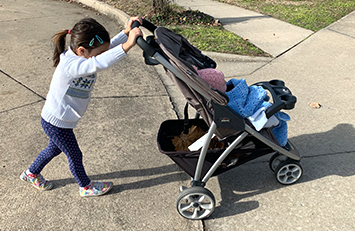
Go on a ramp hunt with your child. How do ramps make it easier for people to do a task?
15 minutes
Get Ready
Materials you will need:
- Cell phone or iPad camera
Things to do before the activity:
- With your child, think of places to find neighborhood ramps. For example, look for a playground slide, a hill, a curb cut, an accessibility ramp, a delivery truck ramp, a skate park ramp, a parking garage ramp, and so on.
- You can go on an indoor ramp hunt if the weather is bad outside.
A character with a speech bubble and crab with a thought bubble.
Let's find ramps that are steep and gentle.
A steep ramp can help things move faster and farther!
Explore!
Step 1.
Before you go outside, take turns naming different places you have seen ramps in your neighborhood. Talk about how each ramp is used.
- What problem does the ramp solve?
- Does the ramp make it easier for someone to do a task?
Step 2.
Go outside and hunt for ramps. Look for ramps. When you find a ramp, talk with your child about how people are using the ramp or about a time you saw someone use the ramp. Notice how the ramp makes a task easier for someone.
- Point out that an object tends to move faster down a steep ramp and slower down a gentle ramp.
- Is the ramp steep or gentle?
- Why do you think a (steep/gentle) ramp was a good solution here?
Step 3.
Identify a problem the ramp solves. For each ramp you find, notice how it helps to solve a problem. For example, a moving truck ramp makes it easier to move a heavy box on or off the truck.
- How does the ramp make the task easier?
- Why would it be harder to do the task without the ramp?
Step 4.
Take pictures of ramps you find. Use the pictures to talk about your ramp hunt exploration.
Review!
Look at the ramp pictures together.
- Name the problem each ramp solves.
- Point out steep and gentle ramps.
- Compare photos. Which ramp is the steepest? The gentlest?